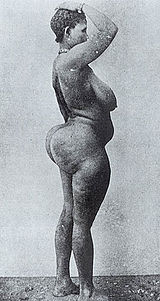
This is a guest post by my friend Ana Vélez. A version of this piece was published in Spanish at her blog, Catrecillo.
The British newspaper The Guardian sparked a controversy in Colombia due to a photo shoot showing the existence of a fashion aesthetic they reasonably call narcoaesthetics.
Why do more girls than boys want to change their appearance? It’s hard to believe that biological forces dominate us in the way they do. The impulses are there, in the genes, and our consciousness seeks explanations to justify the behavior. The fact is that in the human species, the male searches for beauty and youth in females, and the female looks for good genetic inheritance and financial support in the male. From a biological perspective, the female may leave a very small number of offspring compared to the number that a male can leave, so females should choose very carefully with whom to procreate. For males it is enough that the female is attractive and available. How unfair the biological world is; it frightens the reason, but, like it or not, it largely determines our desires and behaviors.
When a young woman decides to have an aesthetic surgery, she is seeking to increase her sex appeal, and she is convinced that the surgery will lead her to have more of it. She can argue that it is a self-esteem issue or that it is because she can improve her status, but basically, if the result of the surgery does not lead to an increase in her sex appeal she would not have it.
Regardless of the culture to which he belongs, the male of the human species detects and perceives as beautiful attributes that females know very well. These attributes are simply the clear signs of youth and fertility: smooth, clean skin without wrinkles; big eyes and full lips (because they become thin and lose color with age); slightly arched and delicate eyebrows, a small chin and clean forehead; long and shiny hair (because it is an indicator of good nutrition and parasite resistance); a symmetrical face, whose features are within the average population; a healthy body without visible infections or diseases, molded by the appropriate hormones; a narrow waist, showing that she is not pregnant or in menopause; wide hips, which foretells an easy delivery, and large breasts, for good feeding. Women that men consider most attractive, be they plump or thin, tall or short, have something in common: by dividing the waist measurement by the hip measurement, the ratio should be between 0.69 and 0.72. Researchers say that this relationship predicts fertility in women. Men of all cultures respond to this relationship, commonly called the guitar shape. Summarizing, males find beauty in the visible signs of a high presence of estrogen and a low amount of testosterone.
But there is another factor that leads young girls to get certain deformities in their bodies: the exaggeration in the size of their breasts and hips, because it is “provocative”. Douglas Jones, author of a study on these characteristics he called supernormal stimuli, defines it as an exaggeration of youthful and female traits by changing the geometry and the proportions of the body. The masculine nature is tempted by the combination of youth and sexual maturity when the woman has the head, face and body of a teenager, but with breasts and hips of adult women.
We recall the experiment conducted by the famous ethologist Nikolaas Tinbergen that focused on the beaks of seagulls. Gull chicks react to the beak of their mother by pecking at it, producing in the mother a regurgitation reflex that feeds them. Interestingly, if the beak is replaced by a somewhat longer rod with two red spots instead of one (the mothers have only one red spot), the chicks react to this by redoubling their desire to peck (biologists call this type of evolution of perception, preference “signal stimuli“).
Without addressing the risks involved in surgery, and thinking only of the benefit that can be obtained with the increase in sex appeal, surgery pays, no matter if we like it or not. For many, the male animal response is inevitable, though absurd and tasteless. And less educated women, those who do not have much more to offer than their beauty, can benefit from this male weakness, and it is not foolish at all. In the narcoaesthetic, breasts and hips are larger than the average global size. The buttocks of women of the Khoikhoi tribe, better known as the Hottentots, are of similar size; and breasts in the drug culture are comparable in size to those exhibited by porn actresses, larger than average.
When a woman is fertile and young, a small physical advantage can translate into a huge advantage in other ways. The most attractive female can choose a good male; this, of course, in the terms in which she understands “good” (and even more seriously: she can find a better job). The collateral problem of displaying these sizzling breasts and hips is that it depends on a surgical procedure and not on Mother Nature. The procedure is accessible to all, frequently done, and being common, the competition returns everyone to the starting point. If everyone has the same characteristics as you do, it is no longer useful as a differentiation, and attention is diverted to other qualities.
Surgery in adult women indicates a clear intention to restore youthfulness. But, it is useless to have youth without beauty or beauty without youth, as François de La Rochefoucauld said. All of us, men and women alike, would like to see ourselves as being attractive, and to look attractive means, biologically, to look youthful, and it is in our hands —or the surgeon’s— to obtain it. People exercise, do yoga, meditate, solve crossword puzzles, read, learn a language, and have surgeries with the same purpose: to fall less obstreperously into old age.
There is no moral or intellectual superiority in wishing to look more beautiful, but there can be skepticism. Some people think that the procedures are still imperfect and ultimately we may lose more than we win; also, it is easy to see that the years are reflected everywhere, not just on the surface, and to change that fact is impossible. But the most pathetic of all is not the fight but the ultimate defeat after many fights. This can be a defeat in which we have lost not only beauty and youth, but also our identity. Surgery can leave us unrecognizable. Nonetheless, if with a magic wand beauty could be ours, everybody would accept it gratefully.
From [Colombian] Semana magazine: “According to the International Society of Aesthetic and Plastic Surgery (ISAP), Colombia is the fifth country where most cosmetic procedures are performed. This is shown by the annual number of such interventions in the country, amounting to 420,955. Of these, between 30 and 40% are breast implants, made on girls and young women under 18 years old”. The phenomenon is interesting because it is complex. Not only does the need for an aesthetic change in the young have to be created (perhaps the supply and demand between boys and girls is disadvantageous for the latter), but also there must be a certain profusion of physicians practicing procedures at a low relative cost, and money must be in the hands of those willing to pay for the procedure. So this is not just a matter of fashion, it is a matter that involves three groups of people who must work in unison, a trio that creates a social phenomenon.
(image: Brazil Women’s Beach Volleyball Team)

